PRUNING AN APPLE TREE, A NECESSARY EVIL
Too Many Blossoms, Too Many Fruits
I winced with almost every snip of the pruning shears yesterday. My apple trees needed pruning and they were loaded with buds showing pink and about to pop open. Pruning was late this year, not that it would matter to the trees, but I had hoped to get it done a month or more ago, before the vegetable garden started beckoning.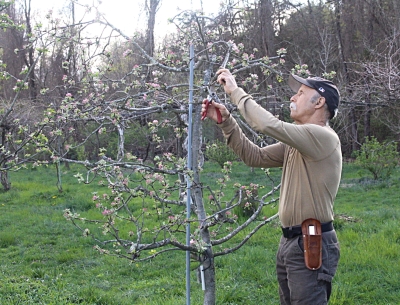
What was making me wince was all the blossoms I was removing, blossoms that, after pollination, could swell into luscious apples. I kept reassuring myself that removing blossoms and, hence, fruit was one of the reasons to prune an apple tree.
Left to its own devices, an apple tree tends to set too many fruits, too many for best quality, that is. With the number of fruits reduced, the tree can channel its energy — evidenced by size and flavor — into those that remain. Each of those buds that were about to pop open housed five flowers, and there were many buds. 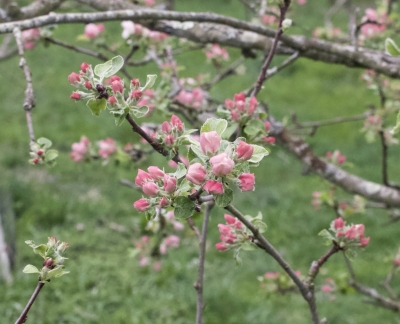 Realizing that only five percent of an apple tree’s flowers need to go on to become fruit for a full crop was soothing.
Realizing that only five percent of an apple tree’s flowers need to go on to become fruit for a full crop was soothing.
Where and Why to Cut
I started my pruning with the more dramatic cuts, of which thankfully few were needed. This was of larger limbs that were too close together, drooping downward, or leaving the trunk at too sharp an angle, the latter making for weak unions. I shortened downward drooping limbs to the point where they were horizontal. Needs for dramatic cuts is minimized for a tree that’s well-trained in its youth.
Next, I looked for overly enthusiastic, vertical sprouts, sometimes called watersprouts, or suckers.  Isn’t enthusiasm good for a plant, a sign of health? Some, yes. Those watersprouts, putting all their energy into growth, tend to be slow to bear fruit. They also shade the interior of the tree and are prone to disease.
Isn’t enthusiasm good for a plant, a sign of health? Some, yes. Those watersprouts, putting all their energy into growth, tend to be slow to bear fruit. They also shade the interior of the tree and are prone to disease.
I walked around and around the tree lopping watersprouts all the way back to where they began growth — unless a weak side shoot or a flower cluster had developed low down on the watersprout. In these cases, I shorten the watersprout to the side shoot or flower cluster. 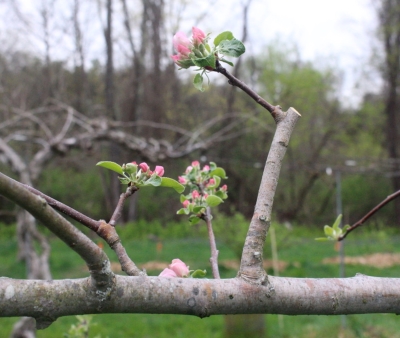 (My trees are all semi-dwarf or dwarf, so I can do all pruning with my feet firmly planted on terra firma.)
(My trees are all semi-dwarf or dwarf, so I can do all pruning with my feet firmly planted on terra firma.)
Finally comes the more detailed pruning, that of flower buds. Most fruit buds are born on spurs, which are short stems that elongate only a half inch or so each year. With age, these spurs look like Lilliputian trees as they branch again and again.
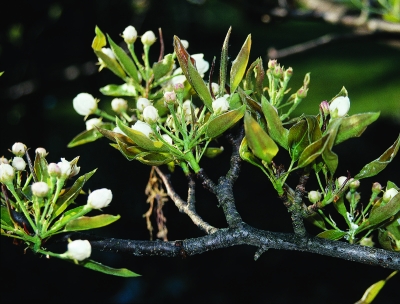
Pear spurs
I remove some of those “branches.” I also ruthlessly remove any spurs growing downwards or from the undersides of branches; they are weak growing and will beget similarly weak offspring.
Not Really Evil
Benefits of annual pruning — and apple trees should get it annually — don’t end with just removing some fruit for the good of those that remain. The trees, like most of our fruit trees, develop fruit buds the summer before their spring display. 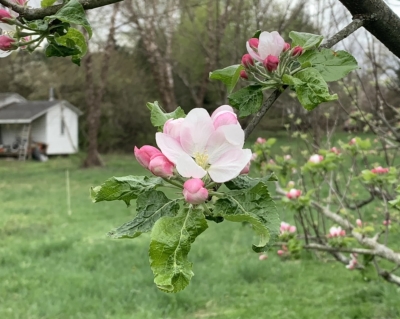 But hormones in seeds of developing fruits suppress flower bud initiation. The result: a big crop one year leads to a paltry crop the next, which can lead to a repeating cycle of feast and famine. So pruning that removes flowers is good for next years flowers and fruit.
But hormones in seeds of developing fruits suppress flower bud initiation. The result: a big crop one year leads to a paltry crop the next, which can lead to a repeating cycle of feast and famine. So pruning that removes flowers is good for next years flowers and fruit.
Yesterday’s cuts also let plenty of sunlight and air movement in among the branches. Sunlight is important for photosynthesis, which translates to good fruit flavor and growth. And the combination of sunlight and air provides an inhospitable environment for diseases.
Some of those cuts I made, depending on where I cut, and how much, influence and direct new growth. Shortening stems coaxes buds on remaining portions to sprout; the more severe the cut, the more vigorous the growth of sprouts.
Some of the above mentioned watersprouts that were sedate in their growth have potential to sport fruit buds in the future. To that end, I shortened them in varying degrees: the weaker the growth, the less I shortened them.  I cut a moderate amount off watersprouts of moderate vigor; they would sprout moderately vigorous shoots from their upper buds, but buds lower down could turn into fruit buds.
I cut a moderate amount off watersprouts of moderate vigor; they would sprout moderately vigorous shoots from their upper buds, but buds lower down could turn into fruit buds.
Admiration
After finishing up the pruning I stood back to admire my handiwork. Hmmm. The trees looked pretty good. They still have plenty of blossoms, and will still bear more than they can ripen to best quality. After threats of late frost and plum curculio, an early season insect pest, have passed, I’ll thin developing fruits by hand. That’s as it should be.
(The above words cover pruning a mature apple tree. My book The Pruning Book covers pruning young and old, neglected apple trees as well as a host of other ornamental and fruiting trees, shrubs, and vines.)
Make Your Own Fruit Trees
Just a reminder about my upcoming grafting workshop, on April 30; learn about grafting and then make your own pear tree to take home and plant. More information and registration (deadline April 27) at www.leereich.com/workshops.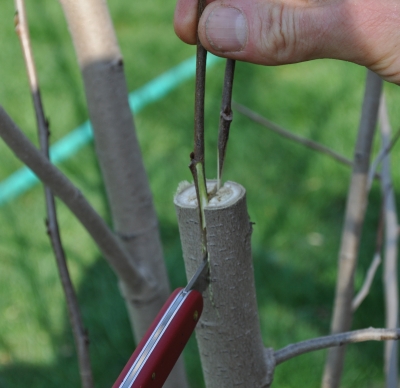


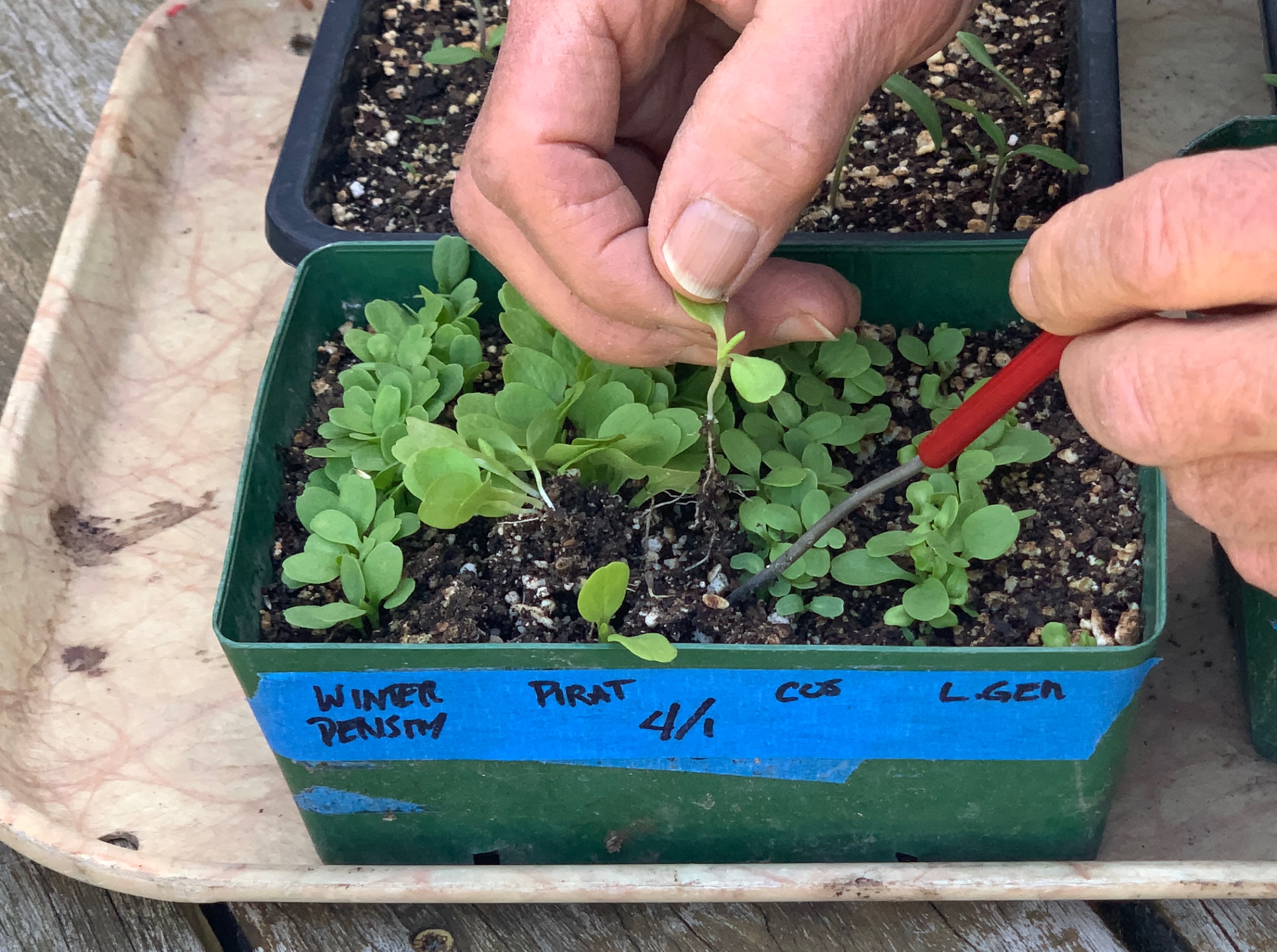
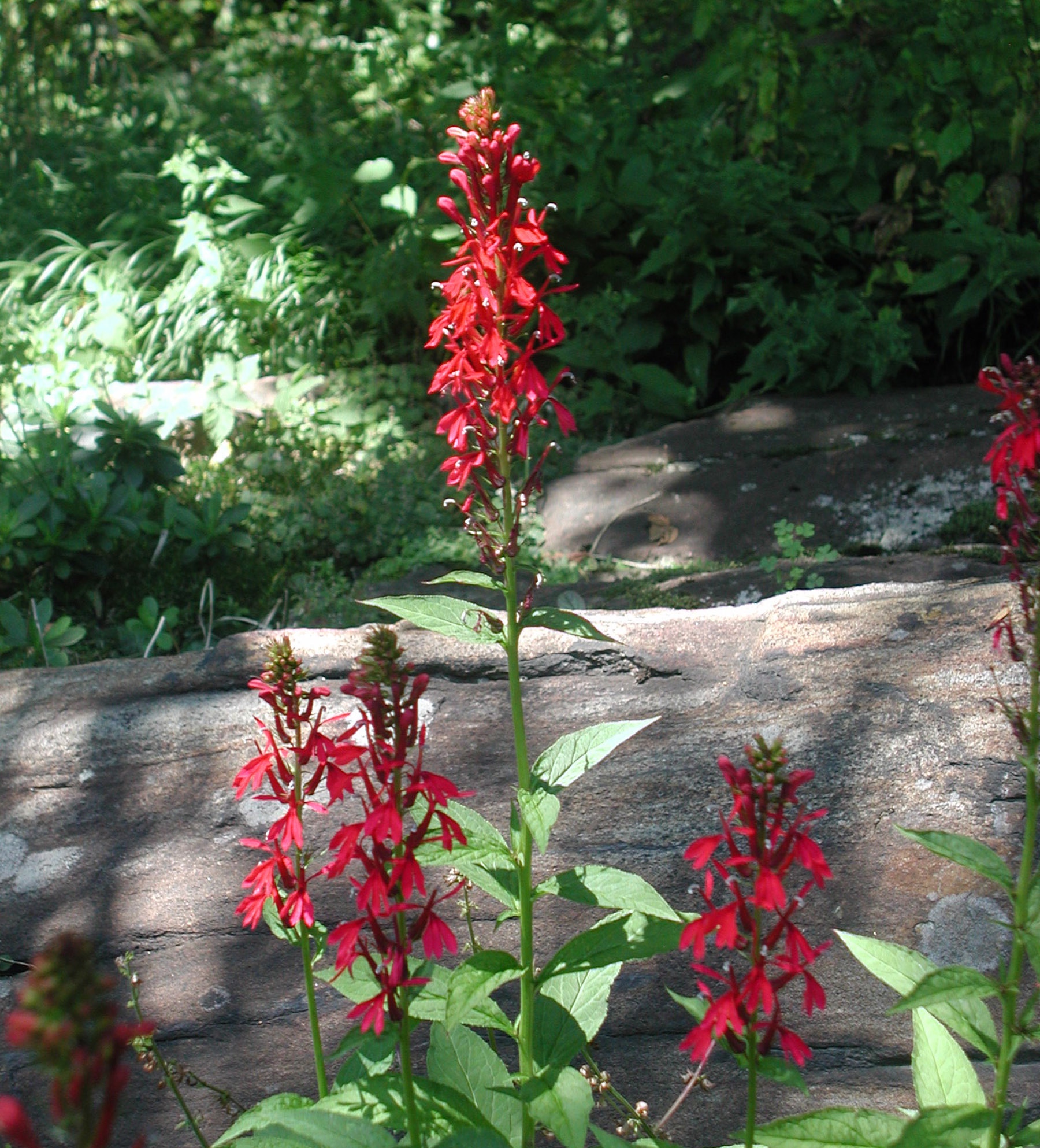
Your pruning book is on my bookshelf and is referenced frequently.
I have a couple 10 year old espalier apple trees I raised from whips that give me quiet satisfaction when I prune them. The local bears mauled them one year but a hot wire fixed that.
I’m glad my book helped. Bears should know not to touch espaliers!
thank you for making this article very useful and keep up the good work
Thanks for helping me understand that tree pruning on an annual basis for apple trees will be important to keep the good parts on. It seems like I have to learn about these things and when they should be done depending on the species of plants we have in our backyard. And this is our first time to have various plants to take care of because we never had a huge backyard before, so I guess it will be easier and beneficial if we have a professional to hire for those kinds of services.
I suggest learning about needed pruning and doing it yourself (unless you don’t have the time or energy). Learning about pruning, doing it, and seeing the effects (even negative, as you learn) are among things that make gardening so interesting and enjoyable.
THANK YOU FOR THE ADVISE
Lee and all, we are now in Australia , and one of the members here has a lot of bushy , vegetative apple trees ( Pink Lady) .
I guess tying limbs to horizontal will encourage more fruiting next year if it is done before late fall ? It is analogous to late June right now in Australia.
Probably the earlier in the growing season, the better as far as quicker response to limb tying.